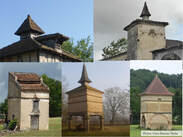|
Forteresse de Salses: discovering history on the autoroutes of France
|

An autoroute rest area with a difference: discover the Forteresse de Salses, built in 1497, besieged many times until it was made redundant in 1659 by the Treat of the Pyrenees which moved the border 40 kilometres further south. forteresse-de-salses-discovering-history-on-the-autoroutes-of-france.html
|
|
Equal opportunities on the Canal du Midi in 1669
|

Pierre-Paul Riquet offered his workers sick pay, holiday pay, monthly pay, equal pay, and he expressed a preference for employing females. Why did he make such a generous and enlightened offer? equal-opportunities-in-1669.html
|
|
Pigeonniers in the urban landscape of Toulouse
|

Follow this 22-kilometre circuit in Toulouse and discover eight magnificent pigeonniers built between the 17th and 19th centuries. pigeonniers-in-the-urban-landscape-of-toulouse.html
|
|
The mysterious object in the lake
|

The obelisk in the lake at Saint-Ferréol only shows itself during times of extreme drought (eg 2022) or when the lake is drained for maintenance (last done in the winter of 2016-17). What is its purpose? the-mysterious-object-in-the-lake.html
|
|
Pigeonniers: the inside story
|

Arguably, no creature has had more beautiful homes built for it than the pigeon, and the 6,000 that remain in our region display an astonishing variety of shapes, sizes and styles. This raises an obvious question: why did so many people go to so much trouble to house a bird? pigeonniers-the-inside-story.html
|
|
The Canal du Midi at Béziers
|

When it was opened in 1682, the Canal du Midi was called the Eighth Wonder of the World, a 240km waterway connecting Toulouse to the Mediterranean. From its highest point at Naurouze, the canal descends 189 metres to the sea via 45 locks. Perhaps the most impressive of these hydraulic lifts is the flight just outside Béziers called the Nine Locks of Fonsérannes. the-canal-du-midi-at-beziers.html
|
|
A rare look inside a pigeonnier or dovecote
|

A couple of months ago, a local historian told me about a pigeonnier which, he assured me, was the most fascinating example he had ever seen. Since then, I have been waiting for the harvest to finish so that I can take a look inside without trampling the farmer’s crops. Earlier this week, the monument’s owner – Monsieur Albouy – announced that my wait was over. I took a short drive over to Saint-Germain-des-Prés near Puylaurens, and then off we went across the stubble armed with a ladder and a camera. inside-a-very-special-pigeonnier.html
|
|
On the ice house trail in the Montagne Noire
|

Pradelles-Cabardès lies just below the highest point of the Montagne Noire – the Pic de Nor. A century ago, this tiny mountain village dominated the ice industry in our region. The best way to grasp the scale of this enterprise is to take a stroll along Le Sentier des Glacières (The Icehouse Trail). not-sure-what-to-do-in-winter-visit-an-icehouse.html
|
|
Why was Thomas Jefferson so determined to visit this pretty lake at Saint-Ferréol?
|

Saint-Ferréol is a ten-minute drive from my home in the Lauragais, and with temperatures forecast to top 40 degrees Celsius this afternoon, I’ll be going there for a swim as soon as I finish writing this post. Thomas Jefferson, in contrast, was more interested in the engineering aspects of Saint-Ferréol because it is, in fact, a reservoir, not a lake. why-was-thomas-jefferson-so-determined-to-visit-this-pretty-lake.html
|
|
Fired up about ice: restoring an icehouse at Pradelles-Cabardès
|

Thank you, Daniel and Marie-Christine Bertherat, for sharing your enthusiasm for ice houses and showing me your unusual restoration project. A century ago, ‘les glacières inépuisables de la Montagne Noire’ seemed truly inexhaustible, and the tiny village of Pradelles-Cabardès supplied ice to towns as far afield as Bordeaux, Perpignan and Toulouse. fired-up-about-ice.html
|
